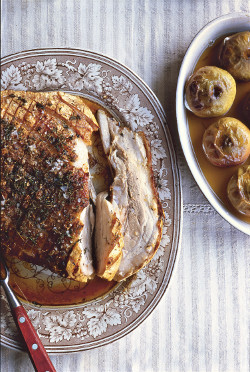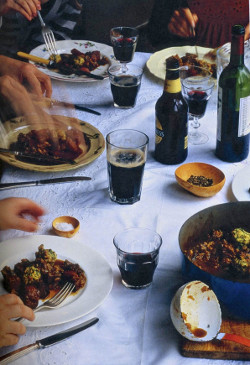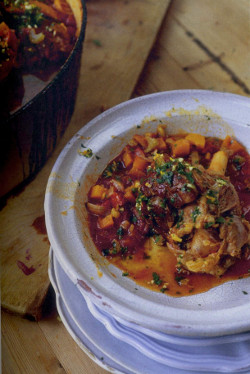A Trio of Classics with Irish Meats
 This time of year is always deceptive, the days are getting longer and everybody starts talking about spring but it’s often the coldest time of all. What’s needed in the kitchen is recipes for some fine big meals with plenty of good Irish meat and vegetables to keep out the cold.
This time of year is always deceptive, the days are getting longer and everybody starts talking about spring but it’s often the coldest time of all. What’s needed in the kitchen is recipes for some fine big meals with plenty of good Irish meat and vegetables to keep out the cold.
So I’ve gone back to a favourite book, Diana Henry’s Food From Plenty for this month’s recipes. Few food writers can match Diana Henry’s down to earth talent and, although she’s based in the UK and best known for her column in the Daily Telegraph, I always think it’s down to her Irish roots.
Great for satisfying family meals, or having friends around, these are also just the kind of simple, hearty dishes we should be able to find in pubs but rarely do.
Thyme-roasted belly of pork with baked apples
“Pork belly has everything going for it. It can be roasted with a crispy crackling or braised to produce tender, melting mouthfuls. And it's cheap.” So says Diana Henry and who can disagree - it’s my favourite cut and it makes the best roast pork of all, far better in my view than the much more expensive (and too lean) loin. The layers of fat in the belly (or ‘lap’) of pork melt during cooking, basting the layers of lean meat (and your roast potatoes) all the while, and the generous amount of crackling is every pork lovers dream come true.
So why is it that, with a few honourable exceptions (Henry Stone comes to mind), Irish chefs can’t cook belly of pork?
Every time I order it in a restaurant it’s more in hope than expectation - and almost invariably it’s a huge disappointment: dry, fussy and presented in prissy little squares with none of its natural simplicity or the wonderful contrast between sweetly succulent meat and crunchy crackling. Move over lads - if you can’t do it right, leave it to the home cooks...
Buy free range pork if at all possible, it makes a big difference to flavour, texture and cooking qualities. Although we need more, there are some good free range pork producers/suppliers, including Caherbeg Free Range Food, Co Cork; Burren Free Range Pork, Kilfenora; Crowes Farm, Tipperary; Rigneys Farm, Co Limerick; Castlemine Farm, Co Roscommon and even Ballymaloe Cookery School, Co Cork.
Serves 8
1.8kg (4lb) thick end of pork belly, rind scored (ask your butcher for the last 6 ribs)
leaves from 1 small bunch of thyme
fine flaked sea salt
freshly ground black pepper
8 smallish eating apples, preferably with tawny or russet skin
200ml (7fl oz) dry cider, white wine or apple juice
50g ( ½ oz) soft light brown sugar
juice of 1/2 lemon
1 Preheat the oven to 220°C/425°F/gas mark 7. Lay the joint, skin side up, in a roasting tin. Rub the thyme leaves and salt and pepper into the skin. Be generous with the salt as this gives crisp crackling. Roast for 30 minutes.
2 Run a knife horizonally round the middle of each apple and put in a baking dish. Heat the cider and sugar gently until the sugar dissolves. Bring just to the boil, add the lemon juice and pour over the apples. Reduce the oven temperature to 180°C/350°F/gas mark 4. Put the apples in the oven and roast them alongside the pork for a further hour (but do check the apples before then: they should be tender yet not collapsing).
3 Test the pork (a joint this size will take up to two hours): the juices should run clear when the meat is pierced. If the crackling isn't crispy enough, increase the oven temperature to 220°C/425°F/gas mark 7 and check again after 5 minutes. Allow to rest before serving each person some meat and crackling, a baked apple and its juices.
 Beef and carrots in stout with parsley and horseradish dumplings
Beef and carrots in stout with parsley and horseradish dumplings
“The stout mellows in the oven to a lovely deep, chocolatey flavour,” says Diana Henry also commenting “You don't need potatoes, making this dish very cook-friendly. Buttered cabbage is delicious with it.”
A few baked potatoes wouldn’t go amiss all the same.
Serves 4-6
FOR THE BEEF
3 tbsp groundnut or sunflower oil
1kg (21b 4oz) braising beef, in large chunks
350g (12oz) carrots, sliced
300g (l0½ oz) leeks, sliced
50g (l¾ oz) pearl barley
1 x 330ml bottle stout
salt and pepper
FOR THE DUMPLINGS
½ onion, very finely chopped
15g (½oz) butter
4 tbsp finely chopped parsley
80g (2½ oz) breadcrumbs
1 large egg
3 generous tbsp creamed horseradish
1 Preheat the oven to 160°C/325°F/gas mark 3. Heat 2 tbsp of the oil in a heavy flameproof casserole and brown the meat in batches. Remove and set aside. Add the remaining oil to the pan and fry the vegetables until lightly coloured, then tip in the barley.
2 Add the stout and stir to deglaze the pan. Pour in 750ml (1¼ pints) water, return the meat and season. Bring to the boil, reduce the heat, cover and put in the oven for 2 hours. Check to make sure the casserole hasn't become dry; add more water if needed.
3 Make the dumplings: saute the onion in the butter, put into a bowl and add the remaining ingredients. Bring the mixture together and form into 12 little golf-ball-sized dumplings. The mixture will be rather loose, but persevere. Dot the dumplings on top of the beef. Cook, covered, for 20 minutes, then uncover and cook for another 10 minutes.
 Braised lamb shanks with gremolata
Braised lamb shanks with gremolata
“Lamb shanks aren't as cheap as they were but are still good value and great reheated, so can be eaten over a couple of meals. You'll have to take whatever size shanks the butcher has, which makes cooking times difficult to specify. Just cook them gently until the meat is parting from the bone. The timings here are for the weight of shanks given; if yours are smaller, check to see when they're ready.”
Serves 8
FOR THE SHANKS
8 Iamb shanks, about 400g (14oz) each
salt and pepper
5 tbsp olive oil
2 onions, chopped
8 carrots, chopped
4 celery sticks, chopped
3 x 400g cans tomatoes in thick juice
600ml (1 pint) dry white wine
several rosemary sprigs
2 bay leaves
3 strips orange zest
FOR THE GREMOLATA
finely grated zest of 1 unwaxed orange
4 garlic cloves, very finely chopped
about 4 tbsp finely chopped flat leaf parsley
1 Preheat the oven to 150°C/300°F/gas mark
2. Remove the fat covering the lamb with a sharp knife. Season the meat. Heat the oil in a large flameproof casserole and brown the lamb, in two batches, on all sides. Set aside. Add the vegetables to the bcasserole and cook until the onions are soft but not coloured. Add the tomatoes, wine and flavourings and bring to the boil. Return the shanks and put in the oven with the lid on for 3-3½ hours, or until the meat is coming away from the bone
3. Remove the lamb and reduce the liquid by boiling until quite thick. Meanwhile, make the gremolata by mixing the ingredients together. Sprinkle over the shanks and serve.





There are currently no comments
Leave a comment
Not a member? Register for your free membership now!
Or leave a comment by logging in with: